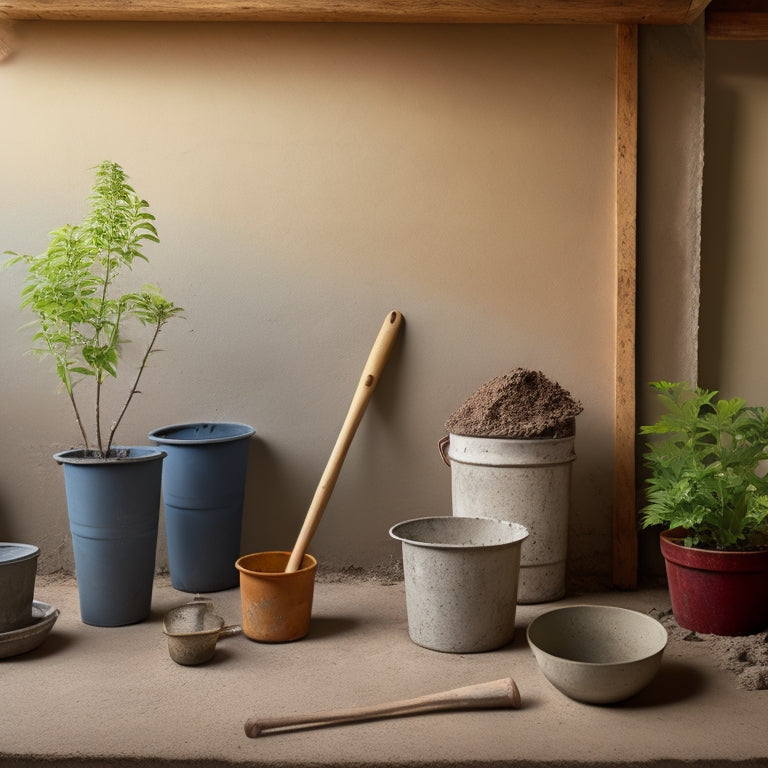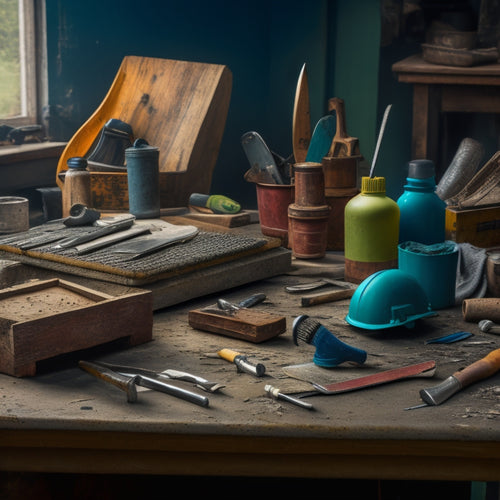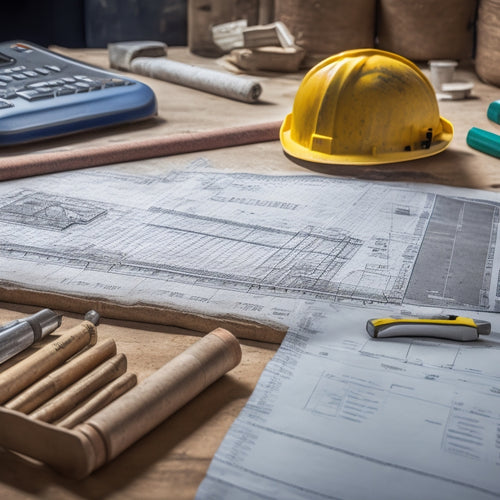
Top 3 Tools for DIY Concrete Projects
Share
You'll need three essential tools to guarantee success in your DIY concrete projects: a reliable concrete mixer, the right block laying tools, and a set of finishing tools to achieve a professional-grade finish. A concrete mixer with a minimum capacity of 3.5 cubic feet and essential safety equipment is a must. For block laying, you'll need a spirit level, rubber mallet, and jointing trowel to guarantee perfectly level and plumb blocks. Finally, a pointing trowel, grinder, and sealing brush will help you achieve a smooth, uniform finish. With these tools, you're off to a strong start - and there's more to explore to take your project to the next level.
Key Takeaways
• A reliable concrete mixer is essential for consistent, high-quality mixes, with a minimum capacity of 3.5 cubic feet recommended.
• A spirit level ensures blocks are perfectly level and plumb to prevent structural issues in block laying projects.
• A jointing trowel is necessary for applying and smoothing mortar between blocks effectively, following manufacturer's instructions for ratios and curing times.
• A pointing trowel is crucial for filling gaps and joints with mortar using techniques like 'V' cut and 'buttering' in finishing touches.
• A grinder is necessary for smoothing rough edges and removing excess material for a uniform finish in concrete projects.
Concrete Mixer Essentials
You'll need a reliable concrete mixer to churn out consistent, high-quality mixes, so start by gathering these essential components. First, decide on the right mixer type for your project. Electric mixers are ideal for small to medium-sized projects, while gasoline-powered mixers are better suited for larger jobs. Consider a mixer with a capacity of at least 3.5 cubic feet to guarantee you can mix enough concrete for your project.
Next, make certain you have the necessary safety equipment. Wear protective gear like gloves, safety glasses, and a dust mask to prevent injury from flying debris and airborne particles. A sturdy ladder or step stool will also come in handy for loading and unloading the mixer.
Don't forget to check the mixer's safety features, such as an emergency stop button and a secure lid latch. Finally, invest in a mixer with a durable, rust-resistant drum and a robust motor that can handle heavy loads.
With these essentials in place, you'll be well on your way to producing high-quality concrete mixes that will make your DIY project a success.
Block Laying Must-Haves
To guarantee accurate and efficient block laying, start by assembling the necessary tools, including a spirit level, a rubber mallet, and a jointing trowel. These three must-haves will ensure you achieve professional-looking results.
First, use your spirit level to check the block alignment tips, making sure each block is perfectly level and plumb. This step is essential, as even the slightest deviation can lead to structural issues down the line.
Next, employ your rubber mallet to gently tap each block into place, avoiding the use of heavy force that can damage the surrounding concrete.
Finally, your jointing trowel will come in handy when applying and smoothing out mortar between the blocks.
Speaking of mortar, proper mixing is key to a successful block-laying project. Make certain to follow the manufacturer's instructions for mixing ratios and curing times to achieve the desired consistency and strength.
With these tools and techniques at your disposal, you'll be well on your way to laying blocks like a pro.
Finishing Touch Tools
Three essential finishing touch tools are required to add the perfect finishing touches to your block-laying project: a pointing trowel, a grinder, and a sealing brush.
You'll use the pointing trowel to fill gaps and joints with a precise amount of mortar, utilizing advanced trowel techniques such as the 'V' cut and 'buttering' to guarantee a strong bond.
Next, the grinder will come into play to smooth out rough edges and remove excess material, allowing you to achieve a uniform finish.
Finally, the sealing brush will be used to apply sealing solutions to protect your concrete from the elements and enhance its appearance.
When selecting a sealing solution, consider factors such as durability, UV resistance, and color retention to guarantee your project looks great for years to come.
Frequently Asked Questions
Can I Use a Drill to Mix Small Batches of Concrete?
When you're working with small batches of concrete, you're probably wondering if you can use a drill to mix it up. The answer is yes, but you'll need to invest in the right drill attachments, like a mixing paddle or a whisk attachment, to get the job done efficiently.
Mastering specific mixing techniques, such as slow and steady circular motions, will also guarantee a smooth, consistent mix.
With the right tools and techniques, you'll be able to achieve professional-grade results.
How Do I Prevent Concrete From Staining My Skin?
When working with concrete, you'll want to prioritize skin care to prevent those pesky stains. You're wise to take precautions!
Wear protective gear like gloves, long sleeves, and pants to create a barrier between your skin and the concrete.
Apply a skin protectant, such as petroleum jelly or a commercial concrete barrier cream, to exposed areas.
After finishing, wash your skin thoroughly with soap and water, then moisturize to maintain healthy skin.
Can I Apply a Second Coat of Sealer Too Soon?
Are you tempted to rush the sealer application process? Don't!
You must wait until the concrete has fully cured, which typically takes 28 days.
Applying a second coat too soon can trap moisture, causing damage or discoloration.
Allow the concrete to complete its curing process before reapplying sealer.
This patience will guarantee a strong, durable bond between the concrete and sealer.
Will Concrete Adhere to a Damp Surface?
When you're working with concrete, you'll want to guarantee the surface is dry and free of excess moisture.
You should know that concrete adhesion is heavily influenced by surface moisture effects. If you apply concrete to a damp surface, it'll struggle to bond properly, leading to weak adhesion and potential structural issues.
To achieve ideal concrete adhesion, you'll need to wait until the surface is completely dry, as even slight moisture can compromise the bond.
Can I Use a Regular Trowel for Finishing Concrete?
'Smoothly sweeping strokes are a must for a flawless finish, but can you rely on a regular trowel to get the job done?
Unfortunately, a standard trowel won't suffice. You'll need a specialized trowel, such as a fresno or darby, designed for finishing techniques like floating and tamping.
These trowel types allow for precise control and even distribution of pressure, ensuring a professional-grade finish.
Invest in the right tool to achieve a polished, pore-free surface that will make your DIY concrete project shine.'
Conclusion
You've made it to the end of our top 3 tools for DIY concrete projects.
With these essentials in your arsenal, you're ready to tackle any concrete project that comes your way.
Did you know that the global concrete market is projected to reach $614.6 billion by 2025? That's a lot of concrete!
With the right tools and a bit of know-how, you can be a part of this booming industry.
Get mixing, laying, and finishing – the world of DIY concrete awaits!
Related Posts
-

Must-Have Handheld Tools for Concrete Repair
When tackling a concrete repair project, it is crucial to have the right handheld tools to achieve a professional fin...
-

Essential Power Tools for DIY Concrete Sculpting
As you begin DIY concrete sculpting, you'll need a strategic selection of power tools to achieve professional-grade r...
-

5 Tips for Accurate Concrete Measurement Tools
To guarantee accurate concrete measurement, you'll want to calibrate your measuring tools regularly, choosing a frequ...


